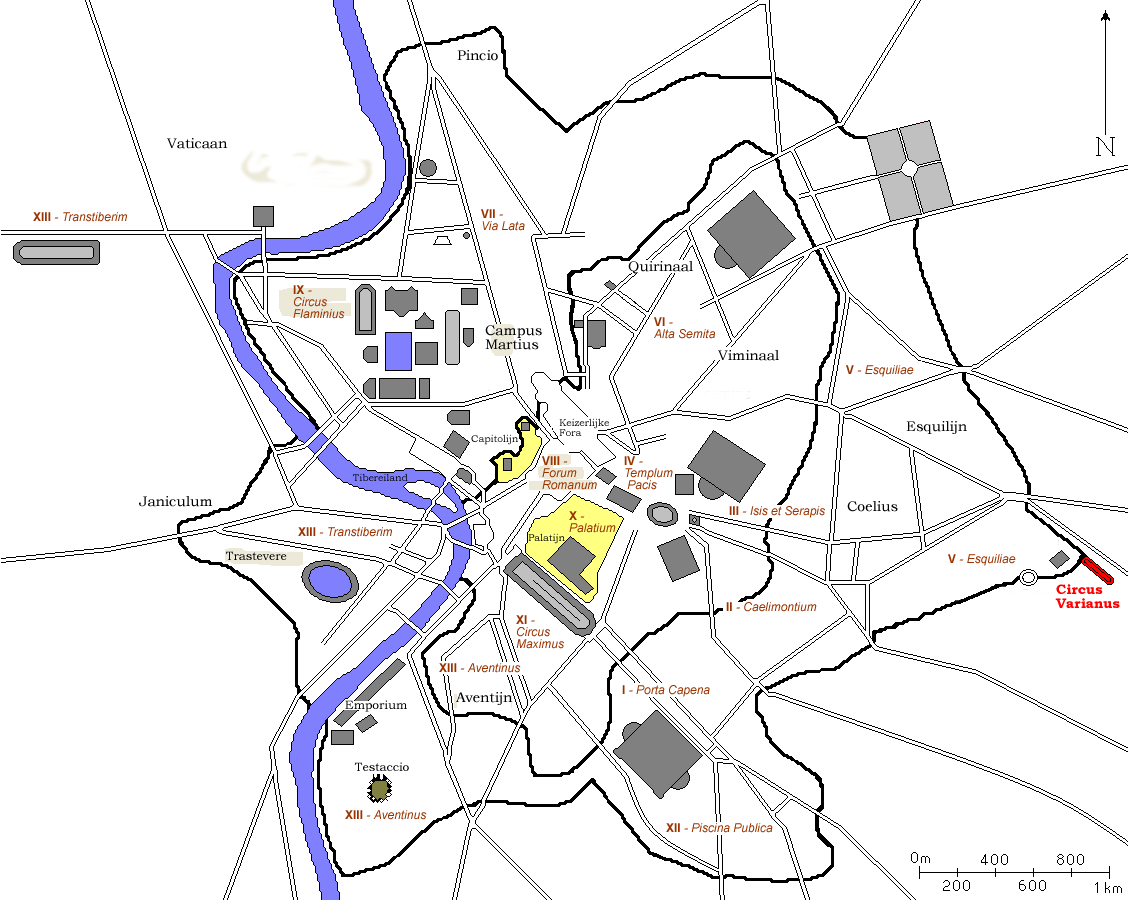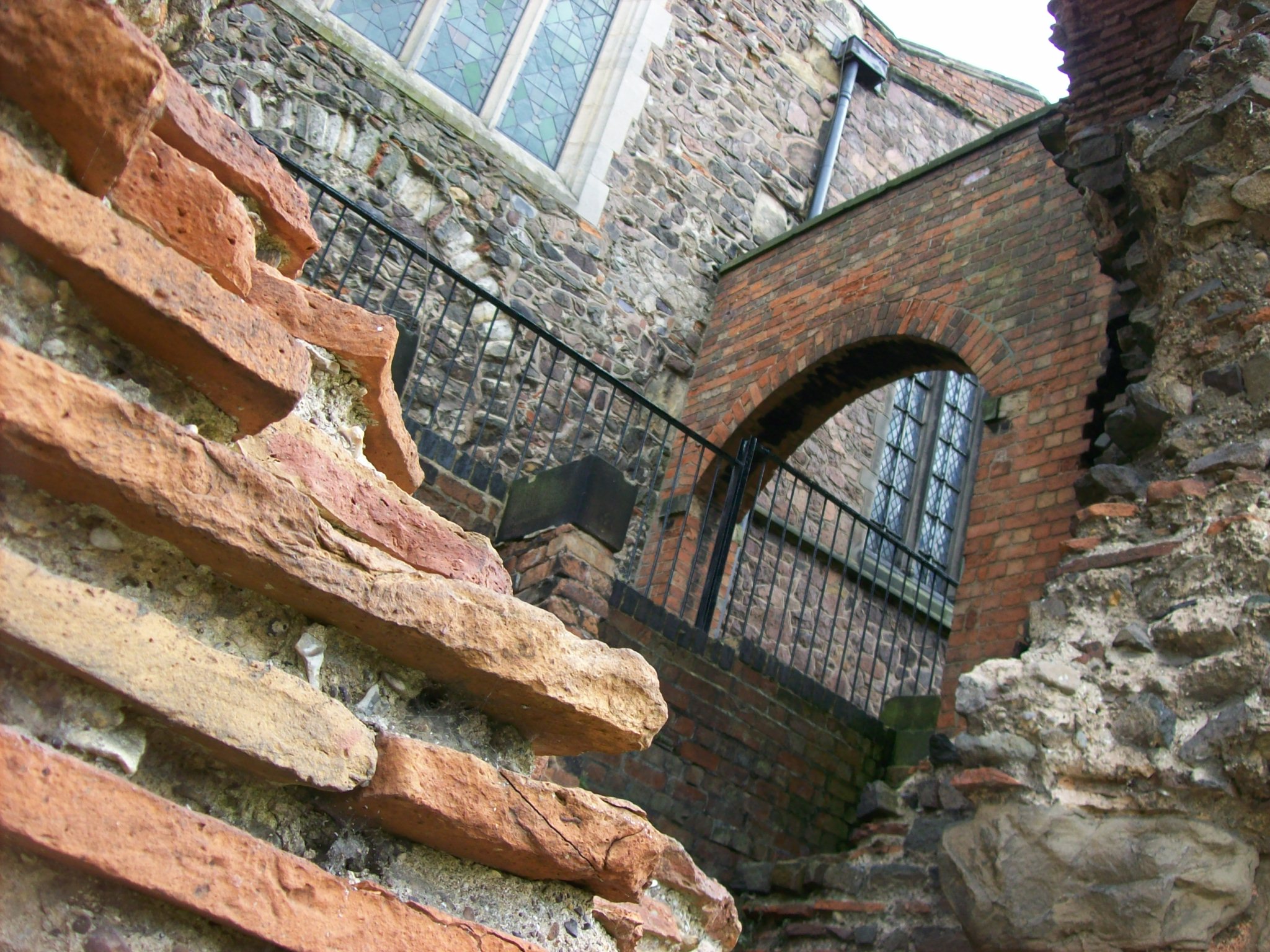|
Amphitheatrum Castrense
The Amphitheatrum Castrense is a Roman amphitheatre in Rome, next to the church of Santa Croce in Gerusalemme.Coulston, J C (01/01/2000). ''Ancient Rome : the archaeology of the eternal city''. eBook Academic Collection (EBSCOhost): Oxford University School of Archaeology. , 978-0-947816-54-4. Both the Amphiteatrum and the Circus Varianus were part of the palatial villa known as the Sessorium. The Regionary Catalogues name it as the "Amphitheatrum Castrense", which could mean it was an amphitheatre connected to an imperial residence, which was not uncommon. History The amphitheatre is dated to the first decades of the 3rd century AD by the style of the bricks and the absence of brick stamps. It was part of an Imperial villa complex which was built by emperors of the Severan dynasty. The open arches of the outer walls were walled up when the building was incorporated into the Aurelian Walls (271–-275 AD), at which point it stopped being used for spectacles and began to be use ... [...More Info...] [...Related Items...] OR: [Wikipedia] [Google] [Baidu] |
List Of Roman Amphitheatres
The remains of at least 230 Roman amphitheatres have been found widely scattered around the area of the Roman Empire. These are large, circular or oval open-air venues with raised 360 degree seating and not to be confused with the more common theatres, which are semicircular structures. There are, however, a number of buildings that have had a combined use as both theatre and amphitheatre, particularly in western Europe. Following is an incomplete list of Roman amphitheatre locations by country. See also * Roman architecture * Circus (building) * Arena * Stadium Related modern building structures * List of contemporary amphitheatres * List of association football stadiums by capacity * List of indoor arenas * List of stadiums References External links Aerial Photographs(Smith's Dictionary of Greek and Roman Antiquities) with Platner article Google Earth file containing several locationsRomanheritage.com site with photos of Roman Amphitheaters {{Ancient Roman architecture ... [...More Info...] [...Related Items...] OR: [Wikipedia] [Google] [Baidu] |
Rome
, established_title = Founded , established_date = 753 BC , founder = King Romulus (legendary) , image_map = Map of comune of Rome (metropolitan city of Capital Rome, region Lazio, Italy).svg , map_caption = The territory of the ''comune'' (''Roma Capitale'', in red) inside the Metropolitan City of Rome (''Città Metropolitana di Roma'', in yellow). The white spot in the centre is Vatican City. , pushpin_map = Italy#Europe , pushpin_map_caption = Location within Italy##Location within Europe , pushpin_relief = yes , coordinates = , coor_pinpoint = , subdivision_type = Country , subdivision_name = Italy , subdivision_type2 = Region , subdivision_name2 = Lazio , subdivision_type3 = Metropolitan city , subdivision_name3 = Rome Capital , government_footnotes= , government_type = Strong Mayor–Council , leader_title2 = Legislature , leader_name2 = Capitoline Assemb ... [...More Info...] [...Related Items...] OR: [Wikipedia] [Google] [Baidu] |
Roman Empire
The Roman Empire ( la, Imperium Romanum ; grc-gre, Βασιλεία τῶν Ῥωμαίων, Basileía tôn Rhōmaíōn) was the post-Republican period of ancient Rome. As a polity, it included large territorial holdings around the Mediterranean Sea in Europe, North Africa, and Western Asia, and was ruled by emperors. From the accession of Caesar Augustus as the first Roman emperor to the military anarchy of the 3rd century, it was a Principate with Italia as the metropole of its provinces and the city of Rome as its sole capital. The Empire was later ruled by multiple emperors who shared control over the Western Roman Empire and the Eastern Roman Empire. The city of Rome remained the nominal capital of both parts until AD 476 when the imperial insignia were sent to Constantinople following the capture of the Western capital of Ravenna by the Germanic barbarians. The adoption of Christianity as the state church of the Roman Empire in AD 380 and the fall of the Western ... [...More Info...] [...Related Items...] OR: [Wikipedia] [Google] [Baidu] |
Amphitheatre
An amphitheatre (British English) or amphitheater (American English; both ) is an open-air venue used for entertainment, performances, and sports. The term derives from the ancient Greek ('), from ('), meaning "on both sides" or "around" and ('), meaning "place for viewing". Ancient Roman amphitheatres were oval or circular in plan, with seating tiers that surrounded the central performance area, like a modern open-air stadium. In contrast, both ancient Greek and ancient Roman theatres were built in a semicircle, with tiered seating rising on one side of the performance area. Modern parlance uses "amphitheatre" for any structure with sloping seating, including theatre-style stages with spectator seating on only one side, theatres in the round, and stadia. They can be indoor or outdoor. Natural formations of similar shape are sometimes known as natural amphitheatres. Roman amphitheatres About 230 Roman amphitheatres have been found across the area of the Roman Empire. ... [...More Info...] [...Related Items...] OR: [Wikipedia] [Google] [Baidu] |
Santa Croce In Gerusalemme
The Basilica of the Holy Cross in Jerusalem or Basilica di Santa Croce in Gerusalemme, ( la, Basilica Sanctae Crucis in Hierusalem) is a Catholic Minor basilica and titular church in rione Esquilino, Rome, Italy. It is one of the Seven Pilgrim Churches of Rome. According to Christian tradition, the basilica was consecrated circa 325 to house the relics of the Passion of Jesus Christ brought to Rome from the Holy Land by Empress Helena, mother of Roman Emperor Constantine I. The basilica's floor was covered with soil from Jerusalem, thus acquiring the title ''in Hierusalem''; it is not dedicated to the Holy Cross of Jerusalem, but the basilica was considered in a sense to be "in Jerusalem" (much in the way that an embassy today is considered extraterritorial). The current Cardinal Priest of the ''Titulus S. Crucis in Hierusalem'' is Juan José Omella. History The basilica is built on the foundations of an imperial villa called ''Horti Variani ad Spem Veterem'' which was begun ... [...More Info...] [...Related Items...] OR: [Wikipedia] [Google] [Baidu] |
Circus Varianus
Circus Varianus was a Roman circus, possibly started during the reign of Caracalla, residing in the palatial villa complex known as the Sessorium, beside the Amphitheatrum Castrense. This circus has been identified as the space in which Elagabalus raced horses under the family name of Varius, lending the site the name of "Circus Varianus." The remnants of the circus survive to the south of Porta Maggiore, next to the Aurelian Wall, near the church of Santa Croce in Gerusalemme. The dimensions of the circus measure 565 x 125 meters, just slightly smaller than the Circus Maximus (600 x 150 m). According to records in the 16th century, an obelisk was found at the site, measuring 9.25 meters tall. It had originally been located at the temple dedicated to Antinous at Antinoöpolis and was moved in the reign of Elagabalus. After being discovered, the obelisk was moved to the Palazzo Barberini in 1633,Richardson, pg. 272 from there to the Vatican Vatican may refer to: Vatican ... [...More Info...] [...Related Items...] OR: [Wikipedia] [Google] [Baidu] |
Roman Brick
Roman brick can refer either to a type of brick used in Ancient Roman architecture and spread by the Romans to the lands they conquered; or to a modern type inspired by the ancient prototypes. In both cases, it characteristically has longer and flatter dimensions than those of standard modern bricks. Ancient The Romans only developed fired clay bricks under the Empire, but had previously used mudbrick, dried only by the sun and therefore much weaker and only suitable for smaller buildings. Development began under Augustus, using techniques developed by the Greeks, who had been using fired bricks much longer, and the earliest dated building in Rome to make use of fired brick is the Theatre of Marcellus, completed in 13 BC. Subsequent uses of fired brick included the Scrongulus Amphitheatre, completed shortly after. Though its use of brick was innovative at the time, the theatre collapsed in a conflict soon thereafter. The process of drying bricks in a kiln made it so these bricks ... [...More Info...] [...Related Items...] OR: [Wikipedia] [Google] [Baidu] |
Severan Dynasty
The Severan dynasty was a Ancient Rome, Roman imperial dynasty that ruled the Roman Empire between 193 and 235, during the Roman imperial period (chronology), Roman imperial period. The dynasty was founded by the emperor Septimius Severus (), who rose to power after the Year of the Five Emperors as the victor of the civil war of 193–197, and his wife, Julia Domna. After the short reigns and assassinations of their two sons, Caracalla () and Geta (emperor), Geta (), who succeeded their father in the government of the empire, Julia Domna's relatives themselves assumed power by raising Elagabalus () and then Severus Alexander () to the imperial office. The dynasty's control over the empire was interrupted by the joint reigns of Macrinus () and his son Diadumenian (). The dynasty's women, including Julia Domna, the mother of Caracalla and Geta, and her nieces Julia Soaemias and Julia Mamaea, the mothers respectively of Elagabalus and Severus Alexander, and their own mother, Ju ... [...More Info...] [...Related Items...] OR: [Wikipedia] [Google] [Baidu] |
Hypogeum
A hypogeum or hypogaeum (plural hypogea or hypogaea, pronounced ; literally meaning "underground", from Greek language, Greek ''hypo'' (under) and ''ghê'' (earth)) is an underground temple or tomb. Hypogea will often contain niche (architecture), niches for cremated human remains or Loculus (architecture), loculi for buried remains. Occasionally tombs of this type are referred to as built tombs. The term ''hypogeum'' can also refer to any antique building or part of building built below ground such as the series of tunnels under the Colosseum which held slaves (particularly enemy captives) and animals while keeping them ready to fight in the gladiatorial games. The animals and slaves could be let up through trapdoors under the sand-covered arena at any time during a fight. Examples An early example of a hypogeum is found at the Minoan civilization, Minoan Bronze Age site of Knossos on Crete. Hogan notes this underground vault was of a beehive shape and cut into the soft r ... [...More Info...] [...Related Items...] OR: [Wikipedia] [Google] [Baidu] |
Venatio
Venatio ( la, venatio, "hunting", plural ''venationes'') was a type of entertainment in Roman amphitheaters involving the hunting and killing of wild animals. History Venatio was first introduced by Marcus Fulvius Nobilior, who celebrated his Greek campaign by hosting games where gladiators would fight lions and panthers. He was possibly inspired by Alexander the Great's purported pastime of pitting lions against both men and dogs. Exotic wild beasts from the far reaches of the Roman Empire were brought to Rome and hunts were held in the morning prior to the afternoon main event of gladiatorial duels. The hunts were held in the Roman Forum, the Saepta, and in the Circus Maximus, though none of these venues offered protection to the crowd from the wild animals on display. Special precautions were taken to prevent the animals from escaping these venues, such as the erection of barriers and the digging of ditches. Very few animals survived these hunts though they did sometimes defe ... [...More Info...] [...Related Items...] OR: [Wikipedia] [Google] [Baidu] |






